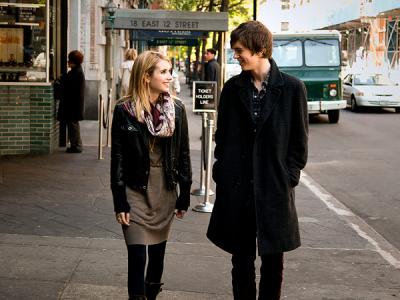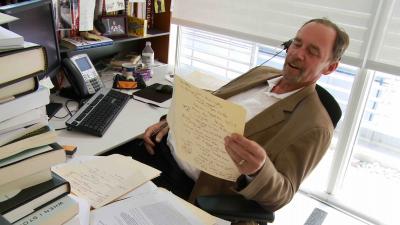A Film Story Made in East Hampton
A Film Story Made in East Hampton

Guild Hall’s Red Carpet Film Series is welcoming one of its own next Thursday with the presentation of the film “The Art of Getting By” by Gavin Wiesen. Not only was the script written in East Hampton, but the writer and director also chose the films for the 2008 to 2010 summer series.
If the title sounds familiar, it is because the film had a limited release in June, garnering positive reviews. It was also a selection of this year’s Sundance Festival, although under another title, “Homework.”
The story is inspired by the filmmaker’s own childhood. He grew up in New York, spending summers and weekends in East Hampton. “My family owned a house in East Hampton since the late 1960s,” he said recently. “From the first couple of years of my life, my earliest memories are of East Hampton.” He described the house as “a modest old cottage, very East Hampton to its core. It’s a great place to be.”
Like many children who grow up in the city or in Los Angeles, he was obsessed with film. “For me, movies were an escape and a connection to the outside world. I had the quintessential only-child-hood.” Although “nothing was tragically wrong,” he said, “movies were a friend to me and a way out of the bubble.” Seeing movies being made around him on the streets of Manhattan only fed the fantasy. “It was extremely meaningful to me while I was very young.”
Attending film school was a “no-brainer,” but “realizing that it was something I could accomplish” took more time. A friend of the family introduced him to producers and directors and he found himself doing coverage on screenplays. “It’s definitely a privilege of growing up in New York. It’s no coincidence that the sons and nephews of filmmakers are filmmakers. It helped me start to believe that getting into that world was possible.”
Mr. Wiesen’s more recent stint in East Hampton had much to do with making the movie happen. Even though he’d spent a good deal of time in movie production in Los Angeles before writing the film, “I realized I needed to write, to create. I needed time to build a body of work. So I pulled up stakes and moved to East Hampton for a couple of years.”
It was at a time when he had reached a crossroads. “I was around 27, 28, becoming overly mature” for the work he was doing. “I was at the point where I thought I might have to give up and find a real job.”
Mr. Wiesen, who is now 36, found himself “lucky to be able to save rent and write screenplays and not be tied to a weekly paycheck for a few years.” He invited a writing partner to come out and stay with him for a month. “It’s such an inspiring place to be. You feel the seasons so intensely.” He said he had fond memories of the summer turning into fall and the days when it became too cold for jogs after work. “How dark it would get. It’s just the loveliest place.”
While he knew some year-round residents, he said he didn’t have much time to see them. “I would go to Rowdy Hall in January and eat at the bar. That was often the only option.” An icy driveway in winter made even that short jaunt precarious.
When it warmed up he began surfing, “something to occupy myself with when I wasn’t working. I picked it up at 29, when the out-of-reach goal of getting good opened up. I spent six years going to Montauk every day. It became an obsession to wake up and go early.”
He finished the screenplay in 2006 and was on the selection committee of the Hamptons International Film Festival the same year. He began trying to get the story made into a film. It took a year to find Gia Walsh, a producer, whose East Hampton house was practically in his backyard.
It was during that time that Mr. Wiesen began working with Guild Hall. He was in Los Angeles, trying to get the movie off the ground and “casting about for work, writing TV pilots,” when, “one way or another, my name came up for programming a summer film series of older foreign films.” In film school he had focused as much on cinema studies as film production, so he was happy for the opportunity. He would “come up with a program of what the films would be and make sure to have enough reasons to be in East Hampton all summer long,” to do introductions and follow-up discussions.
There were always some interesting surprises. One night, Mr. Wiesen presented Luis Bunuel’s “Viridiana” and the audience was treated to an extensive follow-up discussion with none other than Steven Spielberg, who knew Bunuel. Mr. Spielberg had brought his daughter to the screening. At the screening of Louis Malle’s “Au Revoir Les Enfants” were his widow, Candice Bergen, and their daughter, Chloe Malle.
Mr. Wiesen and Ms. Walsh reworked the script in the fall of 2008 and decided it was ready. Then began “the long process to look for the cast and raising money in earnest,” which took about a year.
“I got very lucky with Freddie Highmore,” the star of the film, said Mr. Wiesen. He had not thought of the actor for the part, even though he thought his performance some years ago as a 9-year-old in “Finding Neverland” was stunning. The typical “American-indie Sundance-y lead performance actor is often very good, but pretending to be a slacker when they’re actually going to bars and clubs in L.A. and doing work on TV. They all look familiar.” With Mr. Highmore, though, he said he had an Oscar-caliber actor who was still a 16-to-17-year-old kid. “He brings sweetness to the role.”
The story revolves around a young man with a lot of promise and very little follow-through on the eve of his high school graduation. It is a tale of first love, finding oneself, and conquering the tyranny of trigonometry homework, among other assignments.
Being accepted by Sundance, said Mr. Wiesen, was “an out-of-body experience, more so than any other thing. We went to Sundance with a very high amount of buzz that we didn’t create.”
“The Art of Getting By” turned out to be one of those movies that caught the childhood experience of many people. “It made the financing justifiable. Sundance was the stamp of legitimacy.”
While the distribution was limited, “It couldn’t have had a better journey for a movie this size,” said the writer. “We sold it the day we premiered. I was told that was a thing of the past . . . the producers recouped their investment and then some, something that would have kept me up at night” had it not happened.
Although he said there might have been confusion about how to market the film, he was lucky it came out in any national way. “I thought it would only get released in art houses in New York and L.A.”
Mr. Wiesen hopes his film will have a half-life in cable or DVD release. Meanwhile, he is adapting a book as his next project.



